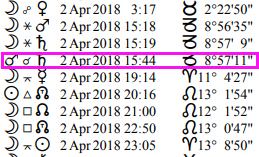Documentación
para Astrólogos.
En
la página de Efemérides Suizas, veréis ahí al lado del año una A mayúscula,
pincháis y os llevará a todos los aspectos entre planetas dados en tiempo
UT
https://www.astro.com/swisseph/swepha_e.htm
·
All
transformation steps from the inertial timeframe of the JPL DE430/431
integration to the reference frame for astrological coordinates (true equinox
of date), all corrections like relativistic aberration, deflection of light in
the gravity field of the Sun etc. have been performed with utmost care and
precision so that the target precision of
0.001 arcsec is maintained through all transformation steps.
Never before has such a high precision ephemeris been available to
astrologers.
·
Swiss Ephemeris
contains three ephemerides. The user can choose whether he/she wants to use the original JPL DE431
data (if available at his/her site), the compressed Swiss Ephemeris data (the
default) or a built in semianalytic theory by Steve Moshier. The Swiss
Ephemeris package switches automatically to the available best precision
ephemeris dependent on which installed ephemeris files it finds. Even without
any stored ephemeris files, using the Moshier model, planetary positions with
better than 0.1 seconds of arc precision are available (3 arcsec for the Moon).
The Moshier ephemeris is based on DE404 and covers the time range 3000 BC –
3000 AD.
Veamos
los datos de la Conjunción Cronocratora JS última del 2000 en Tauro a 22º
43' 17'' a las 16h 04m UT
o 16h 03m 30s TDT
Conjunción Marte_Saturno 2018
Conjunción Marte_Pluton 2018
Conjunción Saturno_Pluton 2020
Conjunción Marte_Saturno 2020
Conjunción Jupiter_Pluton 2020
La
próxima conjunción cronocratora JS del 2020 en Acuario a 0º 29' 10'' a las 18h
21m UT
o las 18h 21m 05s TDT
ect
ect ect...
Es
increíble que a estas alturas del siglo XXI, todavía tengamos que estar
rectificando figuras mal levantadas, bien por utilizar programas no
actualizados, bien por desconocimiento del software usado o bien por la propia
ignorancia del autor.
Es
importantísimo aprender a levantarlas correctamente y después saber aplicarlas
al software astrológico que utilicemos.
Los
planetas deben de estar en los mismos grados , minutos y segundos en longitud
eclíptica para que se produzca un aspecto pártil.
Tampoco
se pueden colocar estrellas con sus posiciones actuales Eclípticas y trasladarlas a tiempos pasados, porque las estrellas se
mueven "y sin embargo se mueven", no son Fijas aunque lo parezcan; además existe la Precesión de los Equinoccios.
Es
lo mínimo que se puede pedir.
Lo
que bien empieza, bien acaba o el que tenga ojos que vea.
Os
dá las gracias la misma Astrología
Albi








No hay comentarios:
Publicar un comentario